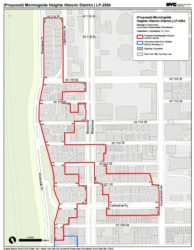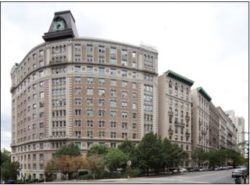
Morningside Heights Historic District Map. Credit LPC.
District is composed of 115 buildings between West 109th and West 199th Streets. On February 21, 2017, the Landmarks Preservation Commission voted to designate the Morningside Heights Historic District, in Manhattan’s Morningside Heights neighborhood. Made up of 115 buildings, the district is characterized by its residential architecture, developed within a relatively short period of time in the early 20th century, for middle and upper class tenants. The district is bounded by West 109th Street to the south, and West 119th street to the north, between Riverside Drive and Amsterdam Avenue.
Before the late 19th century the land, an elevated plateau, was occupied by two institutions, the Leake and Watts Orphan Asylum and New York Hospital’s Bloomingdale Insane Asylum. After the closure of the asylum in the 1890s, the first residential rowhouses were built in the area. Development remained minimal until the extension of the IRT subway to the area in the early 20th century. Speculative development quickly followed the arrival of the IRT, seeing the construction of apartment houses appealing to a middle- and upper-class market. 75 apartment buildings were constructed in the area between 1903 and 1911. Other smaller apartment building, flats and rowhouses composed the rest of the district, where development had all but ceased by the end of the 1920s.
At a hearing on December 6, 2016, elected officials and their representatives, including Congressman Jerrold Nadler, Council member Mark Levine, Assembly Member Daniel O’Donnell, and Manhattan Borough President Gale Brewer spoke in strong support of landmarking, saying it was strongly favored by their constituents, and that out-of-character development threatened the neighborhood’s integrity. Members of the Morningside Heights Community Coalition supported designation, testifying that luxury housing developers threatened the area’s architectural and social fabric. Colombia University Professor Andrew Dolkart, author of a book on the area’s architectural history, said the district was entirely unique in Manhattan’s development. Several individual neighborhood residents also spoke in favor of the designation.

Buildings such as the Paterno located at 440 Riverside Drive make up this new HD. Credit LPC.
A representative of Columbia University objected to the inclusion of four rowhouses owned by the university in the district, claiming they were architecturally insignificant, and were slated for redevelopment as housing. A member of Synagogue Ramath Orah, which falls within the district, said landmarking would impose unsustainable costs on the synagogue. The pastor of Broadway Presbyterian Church also imposed his church’s inclusion, saying the building bore no relationship to the district’s residential architecture.
When the Commission reconvened, Research Department staff advised against altering the district’s boundaries. Staff members said the rowhouses owned by Columbia were of an age and architectural integrity consistent with the rest of the district, and the two religious buildings contributed to the district’s architectural and cultural significance.
Chair Meenakshi Srinivasan said the district possessed “amazing streetscapes,” and the district’s architecture was remarkably cohesive and intact. Commissioner Michael Goldblum called the district a “very distinct place,” and said he believed it to be important to retain the Columbia-owned rowhouses, because they were of a late vintage for New York rowhouses, and provided a counterpoint to the larger apartment buildings. Commissioner Fred Bland praised the Commission’s staff for their “relentless research.”
Commissioners unanimously designate the historic district with unmodified borders.
Srinivasan also announced the launch of a 3-D Web map to make data about the district accessible to property owners and the public.
LPC: Morningside Heights Historic District, Manhattan (LP-2584) (February 21, 2017).
By: Jesse Denno (Jesse is a full-time staff writer at the Center for NYC Law).

